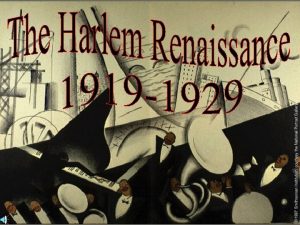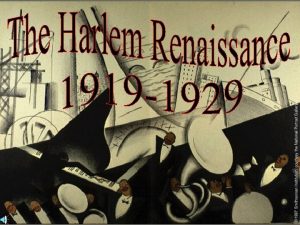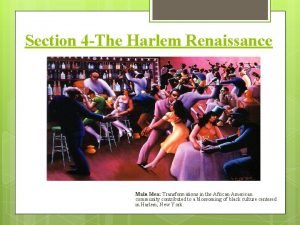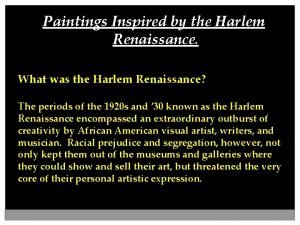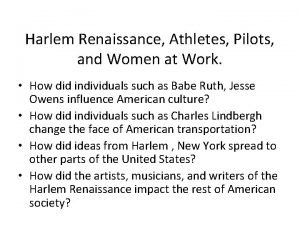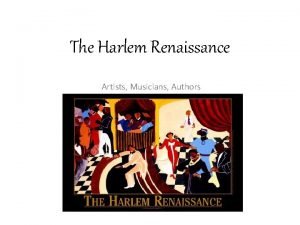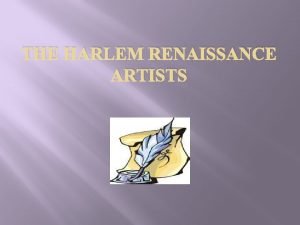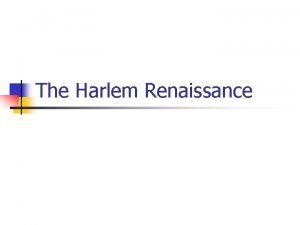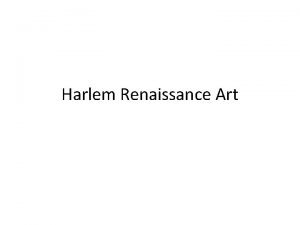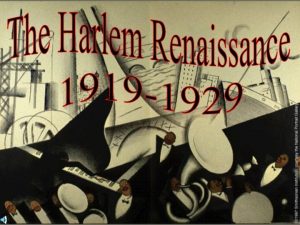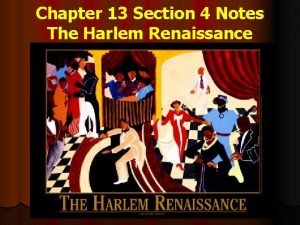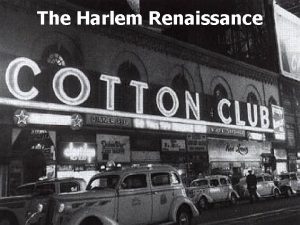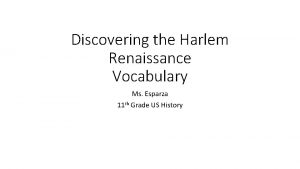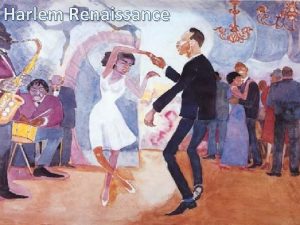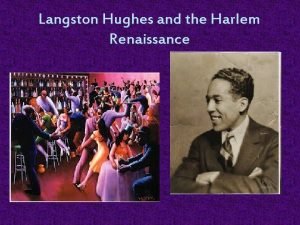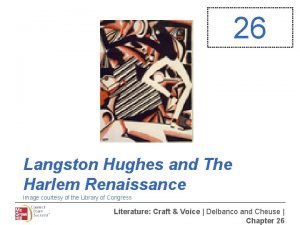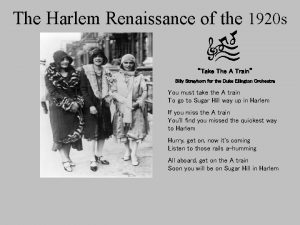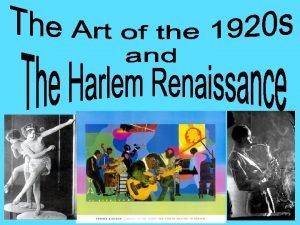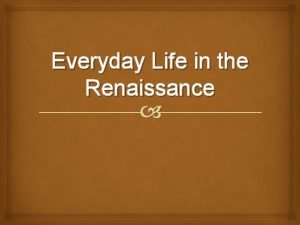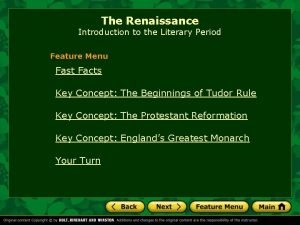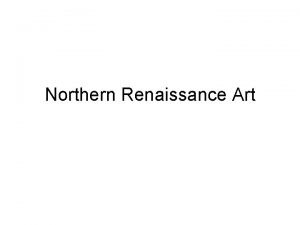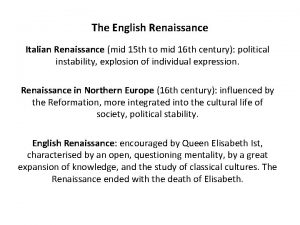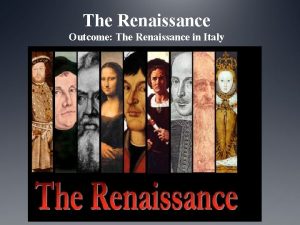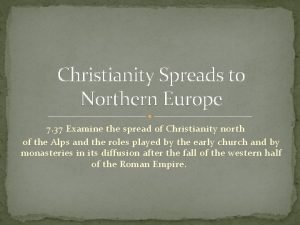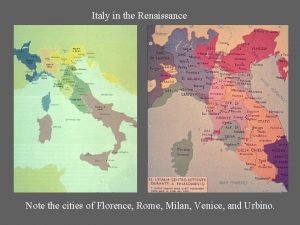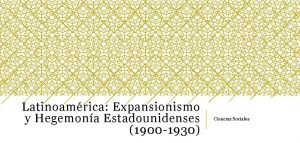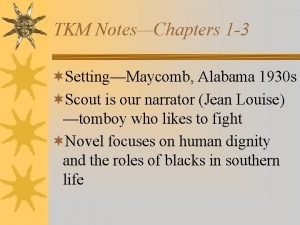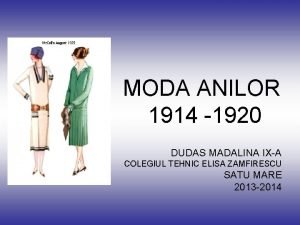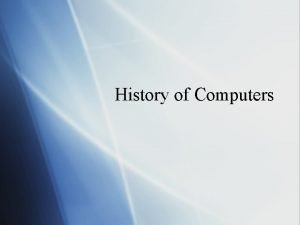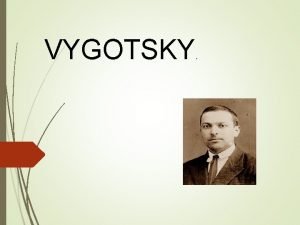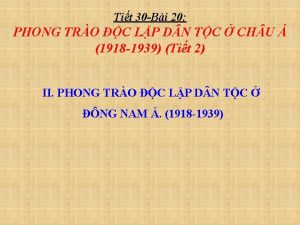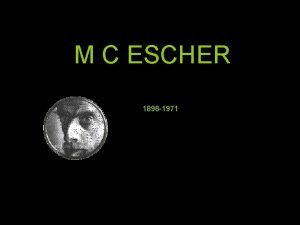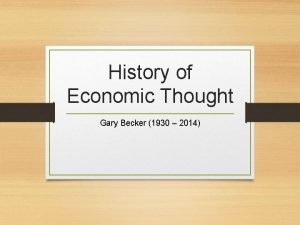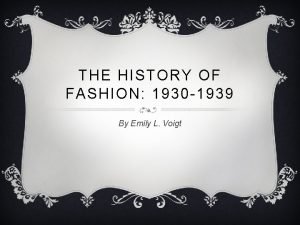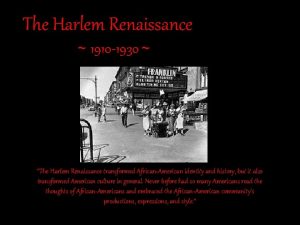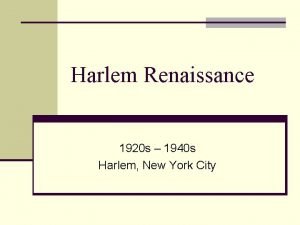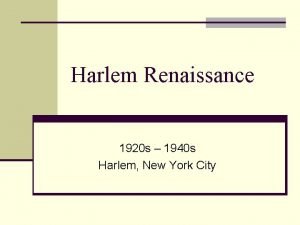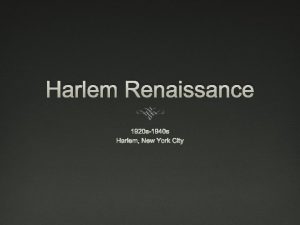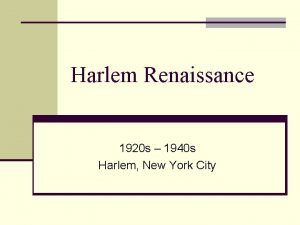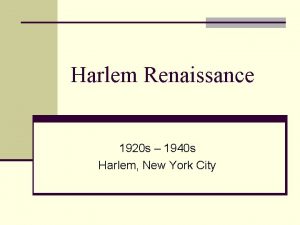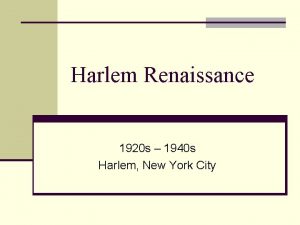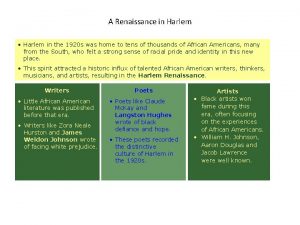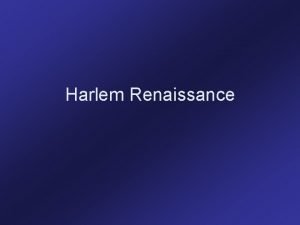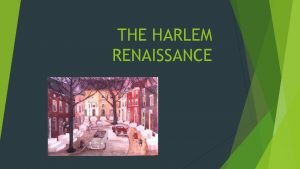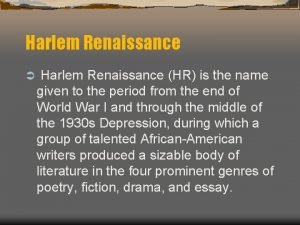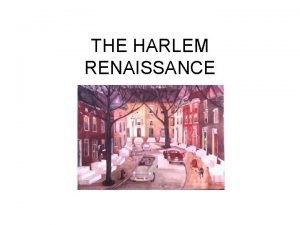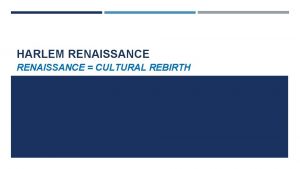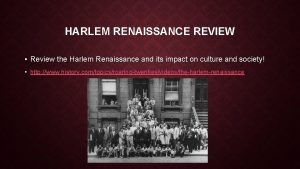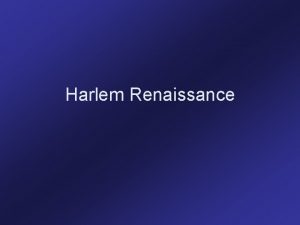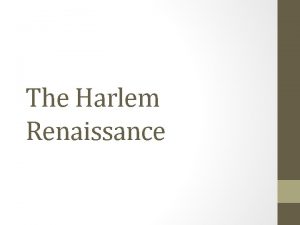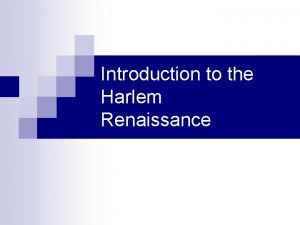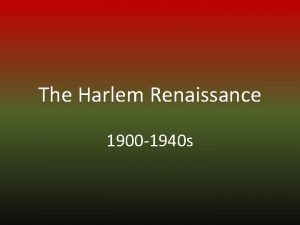The Harlem Renaissance Mid 1920 s Mid 1930

























![Jim Crow +/- 1890/Reconstruction state-sponsored segregation “separate but equal” [Countered in 1954 & 1964] Jim Crow +/- 1890/Reconstruction state-sponsored segregation “separate but equal” [Countered in 1954 & 1964]](https://slidetodoc.com/presentation_image_h2/5b51202e1fe1fd3beb93139ea0bae6ae/image-26.jpg)

























- Slides: 51

The Harlem Renaissance Mid 1920 s – Mid 1930 s

The Piano Lesson Groups Doaker: Boy Willie: Lymon: Berniece: Maretha: Avery: Wining Boy: Grace:


Period Three – Piano Lesson Group One Group Two Doaker: Rajas Doaker: Jaelin Boy Willie: Connery Boy Willie: Drew Lymon: Aaron Berniece: Elena Lymon: Will Berniece: Kate Maretha = Lauren Maretha = Krystal Avery: Shalom Avery: Arjun Wining Boy: Anna B. Wining Boy: Andrew Grace: Christine Grace: Michelle Stage Direction: Jasmine Stage Direction: Johnny

Period Five – Piano Lesson Group One Doaker: Tyrell Boy Willie: Julian Lymon: David Berniece: Elaine Maretha = Meggie Avery: Russel Wining Boy: Justin Grace: Erin Stage Direction: Mallory Group Two

Period Four – Piano Lesson Group One Group Two Doaker = Andy Doaker: Leon Boy Willie: J. D. Boy Willie =Eric Lymon = Brady Berniece = Emma Lymon: Jared Berniece: Brooke Maretha = Yixin Maretha = Sara Avery = Sakura Avery = Cole Wining Boy = Josh Wining Boy = Michael Grace = Lauren Grace: Tina Stage Direction: Clio Stage Direction = Noah

Open wall reading – Piano Lesson Doaker = Andy

Open Wall Read The Piano Lesson Doaker = Rajas Boy Willie =Connery Lymon = Will Berniece = Emma Maretha = Tina Avery = Cole Wining Boy = Michael Grace: Tina Stage Direction = Padgett

Period Three continued Doaker: Braden Williams Boy Willie: Conner Vacca Lymon: Josiah Townsend Berniece: Sidney Maretha + Extra: Kate Avery: Sam Pugel Wining Boy: Tommaso Grace: Shae Extra: Lylienne


Period Four Doaker: Jake Baccetti Boy Willie: Griffin Lymon: Harrison G. Berniece: Cece Belady Maretha + Extra: Angela Avery: Sean Wining Boy: Simon Grace: Sophia Doaker: Sam Mc. Guffin Boy Willie: Michael Lymon: Niki Berniece: Kate Maretha + Extra: Hedda Avery: Jules Van de bospoort Wining Boy: Stefano Grace: Alarie Pierce

Period Four Continued Doaker: Taylor Ranz Boy Willie: Scott Ramseyer Lymon: Grace Thomas Berniece: Nicole Huber Maretha + Extra: none Avery: Cole Johnson Wining Boy: Sophie Kraus Grace: YJ Hou

Period Five Doaker: Quentin Krene Doaker: Dean Workman Boy Willie: Adam Lamin Boy Willie: Tristan Ewing Lymon: Max Weinberg Berniece: Savvy Kaufman Lymon: Niko Berniece: Mia Rotunna Maretha + Extra: Felicia Maretha + Extra: Katrina Avery: Logan Meek Avery: Jarod Wong Wining Boy: Steve Yuk Wining Boy: Austin Taylor Grace: Marieke Kramer Grace: Samantha Moore Extra: Jennifer Young Extra: Sam Sellami


Period Five Continued Doaker: Esther Choe Boy Willie: Brian Oppenheim Lymon: Ole Berniece: Cassey Yabes Maretha + Extra: Megan O’Kane Avery: Josh Stenberg Wining Boy: Robin Corboy Grace: Courtenay Brennan Extras: Joe

Journal Prompt ~ +/5 minutes Who do you think has the right idea about how to deal with the piano, Berniece or Boy Willie? Why? Can you relate this to the legacy of slavery, and the different possible responses? Think of a time in your life when you have felt “wronged” or mistreated. How did you choose to move forward/what was your response? Or have you held onto the memory? Does this match your philosophy?

The Piano Lesson ~ Individually, in your journals. Two questions, one paragraph response each: 1) Using your notes, pick one of the terms we defined (August Wilson, Great Migration, Sharecropping, etc. ) and write a single, short -- but substantial -- paragraph that relates this person or concept to The Piano Lesson. 2) What was the “lesson” you took from The Piano Lesson? Use the play to support your answer.

What was a lesson from The Piano Lesson? “That the past forms the present mindset. ” “That the past is…an untouchable idea that exists in the back of our minds all the time…. like the piano in the living room. ” “That as long as you hold onto the tragedy and hurt in your past, it will continue to haunt you…” “No matter what, it’s important to protect your legacy, and if you don’t, it will haunt you…Boy Willie finally saw the power it [the piano & the past] had. ” “Do not mess around with or look over history”

What was a lesson from The Piano Lesson? “That some people hold onto the past but keep it a secret to help the next generation. Berniece only let her daughter play piano to become a school teacher, but she didn’t tell her the story. ” “To not forget your history…you need to hold onto it because you need to know hard people worked to get something. ” “…taught me to respect my ancestry…” “That you shouldn’t be afraid of your past” “You must actually embrace your past (Berniece finally playing the piano)…”

What was a lesson from The Piano Lesson? “That even within a family, just like our nation, there is disagreement about how to deal with the past. ” “Problems cannot be solved by faceless strangers that come in offering to buy things that don’t have a price. ” “…the importance of communication. The constant clashing…never solved anything. They both had pure intentions…” “No amount of money equals value”


August Wilson, 1945 - 2005 Born Pittsburgh, PA Mother was of African-American heritage. Father was a German immigrant After his parents divorce, he moved into a mostly white suburb. He would transfer into another neighborhood, where he would explore his Pittsburgh “Hill” roots.

Minstrel Shows

Wilson’s 20 th Century Cycle The “Pittsburgh Cycle” Each is set in a different 1900 s Gem of the Ocean decade, depicting the comedy 1910 s Joe Turner’s Come and Gone and tragedy of the African- 1920 s Ma Rainey’s Black Bottom American experience in the 1930 s The Piano Lesson* 20 th century, " a device, ” 1940 s Seven Guiars Charles Whittaker (Ebony) 1950 s Fences* 1960 s Two Trains Running wrote, “that has enabled 1970 s Jitney Wilson to explore, often in 1980 s King Hedley II 1990 s Radio Golf * denotes a Pulitzer Prize very subtle ways, the myriad and mutating forms of the legacy of slavery. "

Sharecropping was a common arrangement during Reconstruction and involves, in theory, a land-owner and a plantation, or agricultural worker sharing profits in exchange for labor.
![Jim Crow 1890Reconstruction statesponsored segregation separate but equal Countered in 1954 1964 Jim Crow +/- 1890/Reconstruction state-sponsored segregation “separate but equal” [Countered in 1954 & 1964]](https://slidetodoc.com/presentation_image_h2/5b51202e1fe1fd3beb93139ea0bae6ae/image-26.jpg)
Jim Crow +/- 1890/Reconstruction state-sponsored segregation “separate but equal” [Countered in 1954 & 1964]

Jim Crow images

Jim Crow

In-class write #1: From the perspective of your character, describe the conflict over the piano. How would he or she describe their own feelings and actions? How would they account for the values and motivations of the other characters? What resolution of the conflict would your character hope for? Who do you think has the right idea about how to deal with the piano, Berniece or Boy Willie? Why? Can you relate this to the legacy of slavery, and the different possible responses? ) Using your notes, pick one of the terms we defined (August Wilson, Great Migration, Sharecropping, etc. ) and write a single, short -- but substantial -paragraph that relates this person or concept to The Piano Lesson. 2) What was the “lesson” you took from The Piano Lesson? Use the play to support your answer. In-class write #3 As noted by Wilson, the two questions that pervade The Piano Lesson are: "What do you do with your legacy, and how do you best put it to use? " Coming from the perspective of your character and using specifics from the play, respond to these questions.

Fact-to-fiction writes 1. Read and enjoy your classmates’ stories. 2. Use the green-colored sheet on the back to provide comments. Remember to put your name on these sheets; both the author and I will be reading them.

Who do you think has the right idea about how to deal with the piano, Berniece or Boy Willie? Why? Can you relate this/their differing feelings to the legacy of slavery, and the different possible responses?

The Piano Lesson: In-class response #2 Using your notes, write one sentence each for three of the terms we defined: August Wilson, Great Migration, Sharecropping, etc. that relate this person or concept to The Piano Lesson.

As noted by Wilson, the two questions that pervade The Piano Lesson are: "What do you do with your legacy, and how do you best put it to use? " Coming from the perspective of a character and using specifics from the play, respond to these questions.

In-class write #3 As noted by Wilson, the two questions that pervade The Piano Lesson are: "What do you do with your legacy, and how do you best put it to use? " How does Wilson answer this question in The Piano Lesson? You do not need to use a quotation, but you should be specific with your support. Include more than one of the character’s perspective.

The Piano Lesson: Pick one for inclass write #2 What are two ways in which The Piano Lesson blurs the boundaries between real time and the past or future? Write a paragraph that makes a connection between the purpose of the play and any one of the following motifs: train, music, ghosts; maternal and/or paternal lineage.

The Harlem Renaissance, definition & background: The term “The Harlem Renaissance” refers to the flourishing of African-American culture between the two world wars. In this period of cultural awakening, African-American literature, music, art, theatre, and political thinking were all energized. The movement developed from a new pride in blackness, an interest in African cultural heritage, and an appreciation of the folkways and creativity of rural and urban blacks. The movement has its roots in W. E. B. Du Bois’s The Souls of Black Folk (1903) and his founding of the magazine The Crisis (1910); it developed with Opportunity: A Journal of Negro Life, founded by the National Urban League (1922) and edited by Charles S. Johnson.


Harlem Renaissance cont. James Weldon Johnson called Harlem “the Negro capital of the world. ” However, the movement is sometimes called the Negro Renaissance as Harlem was just one center of the movement. In 1926, Hughes published “The Negro Artist and the Racial Mountain, ” an essay which provided the Harlem Renaissance with its manifesto as Hughes called boldly for both racial pride and artistic independence. “We younger Negro artists who create now intend to express our individual dark-skinned selves without fear or shame. ”

Langston Hughes criticized the black middle-class for ignoring their own culture in an attempt to appear elite: Let the blare of Negro jazz bands and the bellowing voice of Bessie Smith singing the Blues penetrate the closed ears of the colored near-intellectuals until they listen and perhaps understand. Let Paul Robeson singing ‘Water Boy, ’ and Rudolph Fisher writing about the streets of Harlem, and Jean Toomer holding the heart of Georgia in his hands, and Aaron Douglas’s drawing strange black fantasies cause the smug Negro middle class to turn from their white, respectable, ordinary books and papers to catch a glimmer of their own beauty.

Paul Robeson (but don’t embed it in the video, because it will not work with the override)

Aaron Douglas, 1898 - 1979

Aaron Douglas, 1898 - 1979 “Douglas combined angular Cubist rhythms and seductive Art Deco dynamism with traditional African and African American imagery. ”

Wallace Thurman’s The Blacker the Berry -- cover art by Aaron Douglas


Harlem Renaissance: The Movement Poets like Claude Mac. Kay, Countee Cullen, and Hughes reacted against the erudite, inaccessible poetry of Modernists and wrote more accessible poems. Hughes said that a poem “should be direct, comprehensible, and the epitome of simplicity. ” The poetry of the Harlem Renaissance shuns sentimentality, didacticism, stilted diction, and romantic escape. The poets experiment with black speech patterns, verse forms, and rhythms, often inspired by jazz and the blues.

Harlem Renaissance Continued Music was central to the flowering of the Harlem Renaissance. Jazz clubs such as the Harlem Casino, the Sugar Cane Club, and the Cotton Club entertained both black and white patrons. Harlem was home to Duke Ellington and Fats Waller. Whites comprised a substantial part of the audience. Whites were attracted to what they saw as the exotic in black life and black arts.

Jazz and Blues During the Harlem Renaissance, blues and jazz gained in popularity with African. American and white audiences. The blues is a music that originated in the Deep South. Descended from African. American spirituals and work songs, the blues reflects the hardships of life and love in its lyrics. However, the blues can be humorous as well.

The Major Literary Players in The Harlem Renaissance Writers central to the Harlem Renaissance include Jean Toomer, Claude Mc. Kay, Countee Cullen, Zora Neale Hurston, and James Weldon Johnson. Toomer’s master work is Cane, which combined poetry and fiction in its depiction of African-American life. In their poems, Claude Mc. Kay and Countee Cullen condemned bigotry and racial injustice in often explosive language. Zora Neale Hurston developed fiction and theater based on her personal experience, her anthropological fieldwork, African. American folklore, and Western mythology. However, at the center of the movement was Langston Hughes.

Langston Hughes, 1902 - 1967 • Hughes dropped out of Columbia in 1922 and worked various jobs before working as a seaman and as a newspaper correspondent and columnist for the Chicago Defender, the Baltimore Afro-American, and the New York Post. In late 1924, he returned to live with his mother in Washington, D. C. , where he worked first as an assistant to Carter G. Woodson at the Association for the Study of African American Life and History. Dissatisfied with the work and lack of time to write, he quit. He then worked briefly as a cook at a fashionable restaurant in France and as a busboy in a Washington, D. C. , hotel. It was there that Hughes left three of his poems beside the plate of a hotel dinner guest, the poet Vachel Lindsay, who recognized their merit and helped Hughes secure their publication. Hughes resumed his college studies at Lincoln University in Pennsylvania and earned his B. A. in 1929. After graduation, he settled in Harlem, which he became his primary home for the rest of his life.

Langston Hughes, cont. • Hughes was a prolific writer who worked in many genres: poetry, fiction, nonfiction, drama, musicals, and children’s books. As a popular newspaper columnist, Hughes created a fictitious Harlem narrator named Simple. • His life and travels are richly chronicled in his two volumes of autobiography, The Big Sea (1940) and I Wonder As I Wonder (1956). • His first poem was published at age 19, “The Negro Speaks of Rivers” in The Crisis, and his final book of poems, The Panther and the Lash: Poems of Our Times, the year of his death in 1967. • Deeply interested in developing a black theater, Hughes founded the Harlem Suitcase Theatre in New York in 1938, the New Negro Theater in Los Angeles in 1939, and the Skyloft Players in Chicago in 1942. • His life and work were enormously important in shaping the artistic contributions of the Harlem Renaissance. He wanted to tell the stories of his people in ways that reflected their actual culture, including both their suffering and their love of music, laughter, and language itself.

“I explain and illuminate the Negro condition in America. This applies to 90 percent of my work. ” – Langston Hughes
 New york 1920 map
New york 1920 map Harlem map 1920s
Harlem map 1920s The harlem renaissance main idea
The harlem renaissance main idea Harlem renaissance drawings
Harlem renaissance drawings Harlem renaissance athletes
Harlem renaissance athletes Harlem renaissance
Harlem renaissance Define renaissance
Define renaissance Map of harlem new york
Map of harlem new york Define harlem renaissance
Define harlem renaissance Harlem renaissance brainpop answers
Harlem renaissance brainpop answers The harlem renaissance webquest
The harlem renaissance webquest Harlem renaissance themes
Harlem renaissance themes Harlem renaissance themes
Harlem renaissance themes Chapter 13 section 4 the harlem renaissance answer key
Chapter 13 section 4 the harlem renaissance answer key Harlem renaissance vocabulary
Harlem renaissance vocabulary Bessie smith harlem renaissance
Bessie smith harlem renaissance Mastery connect/bubblesheet
Mastery connect/bubblesheet Harlem renaissance vocabulary
Harlem renaissance vocabulary Harlem renaissance began
Harlem renaissance began Crash course harlem renaissance
Crash course harlem renaissance Facts about the harlem renaissance
Facts about the harlem renaissance The roaring twenties were characterized by
The roaring twenties were characterized by Harlem renaissance poems
Harlem renaissance poems What was the “lost generation”?
What was the “lost generation”? Harlem renaissance inventions
Harlem renaissance inventions Harlem renaissance
Harlem renaissance The renaissance outcome renaissance painters/sculptors
The renaissance outcome renaissance painters/sculptors The renaissance introduction to the renaissance answer key
The renaissance introduction to the renaissance answer key Northern renaissance art vs italian renaissance art
Northern renaissance art vs italian renaissance art Italian renaissance vs english renaissance
Italian renaissance vs english renaissance Cosimo de' medici
Cosimo de' medici The renaissance outcome the renaissance in italy
The renaissance outcome the renaissance in italy Italian renaissance vs northern renaissance venn diagram
Italian renaissance vs northern renaissance venn diagram Renaissance vs high renaissance
Renaissance vs high renaissance Imperialismo moderno
Imperialismo moderno 2007-1930
2007-1930 Maycomb alabama 1930
Maycomb alabama 1930 O golpe de 1930
O golpe de 1930 Moda 1920
Moda 1920 La bestia del mar 1930
La bestia del mar 1930 El puerto rico americano adaptacion y resistencia
El puerto rico americano adaptacion y resistencia Computers 1930s
Computers 1930s Pesem srečka kosovela iz leta 1930
Pesem srečka kosovela iz leta 1930 Linea del tiempo de vigotsky
Linea del tiempo de vigotsky Nguyễn ái quốc 1930
Nguyễn ái quốc 1930 Castrovalva escher
Castrovalva escher Becker 1930
Becker 1930 Kviz o fudbalu
Kviz o fudbalu I lived in calcutta since 1930 correct the sentence
I lived in calcutta since 1930 correct the sentence đảng cộng sản việt nam 1930
đảng cộng sản việt nam 1930 Round table conferences 1930-32
Round table conferences 1930-32 1930-1939 fashion
1930-1939 fashion
